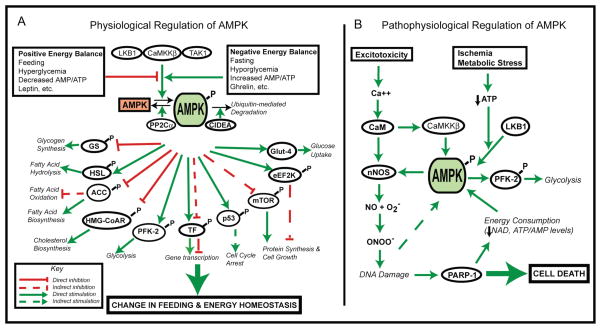Figure 1.
A) Physiological Regulation of AMPK Signaling. AMPK is activated by physiological signals that indicate negative energy balance (fasting, hypoglycemia, elevated AMP/ATP, or neuropeptides such as ghrelin). In contrast, AMPK is inhibited by signals indicating positive energy balance (feeding, hyperglycemia, decreased AMP/ATP, or adipokines such as leptin). Upon phosphorylation by an upstream kinase (LKB1, CaMKKβ, or TAK-1) AMPK elicits diverse effects on fatty acid, cholesterol, and glucose metabolism, and controls cell cycle progression, protein synthesis, and gene expression. B) Pathophysiological Regulation of AMPK Signaling. AMPK is activated in ischemia, producing excitotoxic, oxidative, and metabolic stresses. Under these conditions, with insufficient energy substrate availability, futile energy-consumptive pathways are over-activated, leading to cellular death. Abbreviations:CaMKKβ (Ca2+/calmodulin-dependent protein kinase β), TAK1 (TGFβ-activated kinase 1), PP2Cα (protein phosphatase-2Cα), GS (glycogen synthase), HSL (hormone-sensitive lipase), ACC (acetyl-CoA carboxylase), HMG-CoAR (3-hydroxy-3-methyl-glutaryl-CoA reductase), PFK-2 (phosphofructokinase-2), TF (Transcription factors), p53 (tumor protein 53), mTOR (mammalian target of rapamycin), eEFK2K (eukaryotic elongation factor-2 kinase), Glut-4 (glucose transporter), nNOS (neuronal nitric oxide synthase), NO (nitric oxide), ONOO− (peroxynitrite), PARP-1 (poly (ADP-ribose) polymerase family member 1).

